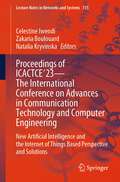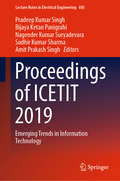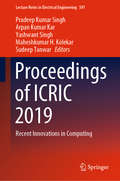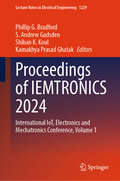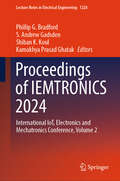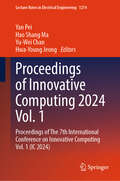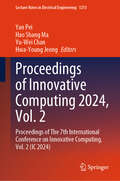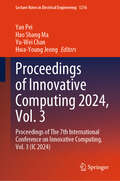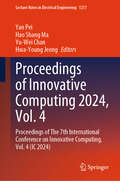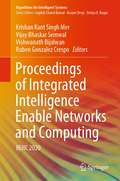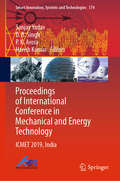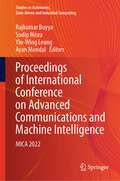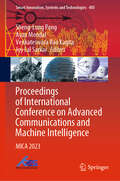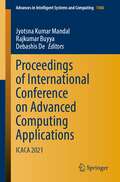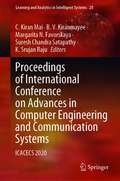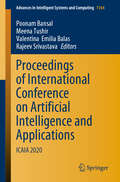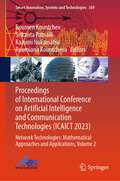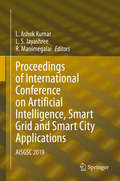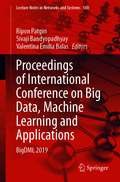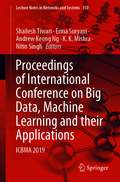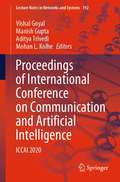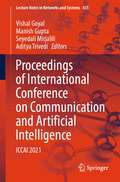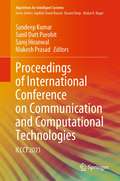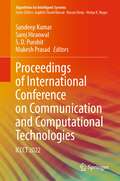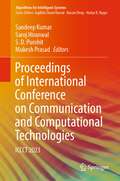- Table View
- List View
Proceedings of ICACTCE'23 — The International Conference on Advances in Communication Technology and Computer Engineering: New Artificial Intelligence and the Internet of Things Based Perspective and Solutions (Lecture Notes in Networks and Systems #735)
by Natalia Kryvinska Zakaria Boulouard Celestine IwendiToday, communication technology and computer engineering are intertwined, with advances in one field driving advances in the other, leading to the development of outstanding technologies. This book delves into the latest trends and breakthroughs in the areas of communication, Internet of things, cloud computing, big data, artificial intelligence, and machine learning.This book discusses challenges and opportunities that arise with the integration of communication technology and computer engineering. In addition, the book examines the ethical and social implications, including issues related to privacy, security, and digital divide and law. We have explored the future direction of these fields and the potential for further breakthroughs and innovations.The book is intended for a broad audience of undergraduate and graduate students, practicing engineers, and readers without a technical background who have an interest in learning about communication technology and computer engineering.
Proceedings of ICETIT 2019: Emerging Trends in Information Technology (Lecture Notes in Electrical Engineering #605)
by Bijaya Ketan Panigrahi Pradeep Kumar Singh Nagender Kumar Suryadevara Sudhir Kumar Sharma Amit Prakash SinghThis book presents high-quality, original contributions (both theoretical and experimental) on Information Security, Machine Learning, Data Mining and Internet of Things (IoT). It gathers papers presented at ICETIT 2019, the 1st International Conference on Emerging Trends in Information Technology, which was held in Delhi, India, in June 2019. This conference series represents a targeted response to the growing need for research that reports on and assesses the practical implications of IoT and network technologies, AI and machine learning, data analytics and cloud computing, security and privacy, and next generation computing technologies.
Proceedings of ICRIC 2019: Recent Innovations in Computing (Lecture Notes in Electrical Engineering #597)
by Arpan Kumar Kar Pradeep Kumar Singh Maheshkumar H. Kolekar Sudeep Tanwar Yashwant SinghThis book presents high-quality, original contributions (both theoretical and experimental) on software engineering, cloud computing, computer networks & internet technologies, artificial intelligence, information security, and database and distributed computing. It gathers papers presented at ICRIC 2019, the 2nd International Conference on Recent Innovations in Computing, which was held in Jammu, India, in March 2019. This conference series represents a targeted response to the growing need for research that reports on and assesses the practical implications of IoT and network technologies, AI and machine learning, cloud-based e-Learning and big data, security and privacy, image processing and computer vision, and next-generation computing technologies.
Proceedings of IEMTRONICS 2024: International IoT, Electronics and Mechatronics Conference, Volume 1 (Lecture Notes in Electrical Engineering #1229)
by Kamakhya Prasad Ghatak Shiban K. Koul Phillip G. Bradford S. Andrew GadsdenThis book gathers selected research papers presented at IEMTRONICS 2024 (International IoT, Electronics and Mechatronics Conference), held during 3–5 April 2024 in London, United Kingdom in hybrid mode. This book presents a collection of state-of-the-art research work involving cutting-edge technologies in the field of IoT, electronics mechatronics, and related areas. The work is presented in two volumes.
Proceedings of IEMTRONICS 2024: International IoT, Electronics and Mechatronics Conference, Volume 2 (Lecture Notes in Electrical Engineering #1228)
by Kamakhya Prasad Ghatak Shiban K. Koul Phillip G. Bradford S. Andrew GadsdenThis book gathers selected research papers presented at IEMTRONICS 2024 (International IoT, Electronics and Mechatronics Conference), held during 3 – 5 April 2024 in London, United Kingdom in hybrid mode. This book presents a collection of state-of-the-art research work involving cutting-edge technologies in the field of IoT, electronics mechatronics, and related areas. The work is presented in two volumes.
Proceedings of Innovative Computing 2024 Vol. 1: Proceedings of The 7th International Conference on Innovative Computing Vol. 1 (IC 2024) (Lecture Notes in Electrical Engineering #1214)
by Hwa-Young Jeong Yu-Wei Chan Yan Pei Hao Shang MaThis book comprises select proceedings of the 7th International Conference on Innovative Computing which was held in Taichung City, Taiwan, Jan 23-26, 2024 (IC 2024) focusing on cutting-edge research carried out in the areas of information technology, science, and engineering. Some of the themes covered in this book are cloud communications and networking, high performance computing, architecture for secure and interactive IoT, satellite communication, wearable network and system, infrastructure management, etc. The essays are written by leading international experts, making it a valuable resource for researchers and practicing engineers alike.
Proceedings of Innovative Computing 2024, Vol. 2: Proceedings of The 7th International Conference on Innovative Computing, Vol. 2 (IC 2024) (Lecture Notes in Electrical Engineering #1215)
by Hwa-Young Jeong Yu-Wei Chan Yan Pei Hao Shang MaThis book comprises select proceedings of the 7th International Conference on Innovative Computing which was held in Taichung City, Taiwan, Jan 23-26, 2024 (IC 2024) focusing on cutting-edge research carried out in the areas of information technology, science, and engineering. Some of the themes covered in this book are cloud communications and networking, high performance computing, architecture for secure and interactive IoT, satellite communication, wearable network and system, infrastructure management, etc. The essays are written by leading international experts, making it a valuable resource for researchers and practicing engineers alike.
Proceedings of Innovative Computing 2024, Vol. 3: Proceedings of The 7th International Conference on Innovative Computing, Vol. 3 (IC 2024) (Lecture Notes in Electrical Engineering #1216)
by Hwa-Young Jeong Yu-Wei Chan Yan Pei Hao Shang MaThis book comprises select proceedings of the 7th International Conference on Innovative Computing which was held in Taichung City, Taiwan, Jan 23-26, 2024 (IC 2024) focusing on cutting-edge research carried out in the areas of information technology, science, and engineering. Some of the themes covered in this book are cloud communications and networking, high performance computing, architecture for secure and interactive IoT, satellite communication, wearable network and system, infrastructure management, etc. The essays are written by leading international experts, making it a valuable resource for researchers and practicing engineers alike.
Proceedings of Innovative Computing 2024, Vol. 4: Proceedings of The 7th International Conference on Innovative Computing, Vol. 4 (IC 2024) (Lecture Notes in Electrical Engineering #1217)
by Hwa-Young Jeong Yu-Wei Chan Yan Pei Hao Shang MaThis book comprises select proceedings of the 7th International Conference on Innovative Computing which was held in Taichung City, Taiwan, Jan 23-26, 2024 (IC 2024) focusing on cutting-edge research carried out in the areas of information technology, science, and engineering. Some of the themes covered in this book are cloud communications and networking, high performance computing, architecture for secure and interactive IoT, satellite communication, wearable network and system, infrastructure management, etc. The essays are written by leading international experts, making it a valuable resource for researchers and practicing engineers alike.
Proceedings of Integrated Intelligence Enable Networks and Computing: IIENC 2020 (Algorithms for Intelligent Systems)
by Rubén González Crespo Vijay Bhaskar Semwal Krishan Kant Singh Mer Vishwanath BijalwanThis book presents best selected research papers presented at the First International Conference on Integrated Intelligence Enable Networks and Computing (IIENC 2020), held from May 25 to May 27, 2020, at the Institute of Technology, Gopeshwar, India (Government Institute of Uttarakhand Government and affiliated to Uttarakhand Technical University). The book includes papers in the field of intelligent computing. The book covers the areas of machine learning and robotics, signal processing and Internet of things, big data and renewable energy sources.
Proceedings of International Conference in Mechanical and Energy Technology: ICMET 2019, India (Smart Innovation, Systems and Technologies #174)
by D. B. Singh Harish Kumar Sanjay Yadav P. K. AroraThis book presents selected peer-reviewed papers from the International Conference on Mechanical and Energy Technologies, which was held on 7–8 November 2019 at Galgotias College of Engineering and Technology, Greater Noida, India. The book reports on the latest developments in the field of mechanical and energy technology in contributions prepared by experts from academia and industry. The broad range of topics covered includes aerodynamics and fluid mechanics, artificial intelligence, nonmaterial and nonmanufacturing technologies, rapid manufacturing technologies and prototyping, remanufacturing, renewable energies technologies, metrology and computer-aided inspection, etc. Accordingly, the book offers a valuable resource for researchers in various fields, especially mechanical and industrial engineering, and energy technologies.
Proceedings of International Conference on Advanced Communications and Machine Intelligence: MICA 2022 (Studies in Autonomic, Data-driven and Industrial Computing)
by Sudip Misra Rajkumar Buyya Yiu-Wing Leung Ayan MondalThis book presents high-quality, peer-reviewed papers from International Conference on Advanced Communications and Machine Intelligence (MICA 2022), organised by M.Kumarasamy College of Engineering, Chennai, Tamil Nadu, India, during 9–11 December 2022. The book includes all areas of advanced communications and machine intelligence. The topics covered are network performance analysis, data mining and warehousing, parallel and distributed networks, computational intelligence, smart city applications, big data analytics, Internet of Things networks, information management and wireless sensor networks. The book is useful for academicians, scientists, researchers from industry, research scholars and students working in these areas.
Proceedings of International Conference on Advanced Communications and Machine Intelligence: MICA 2023 (Smart Innovation, Systems and Technologies #405)
by Sheng-Lung Peng Ayan Mondal Venkateswara Rao Kagita Joy Lal SarkarThis book presents high-quality, peer-reviewed papers from International Conference on Advanced Communications and Machine Intelligence (MICA 2023), hosted by National Institute of Technology Warangal, Telangana, India, during 30–31 October 2023. The book includes all areas of advanced communications and machine intelligence. The book is useful for academicians, scientists, researchers from industry, research scholars, and students working in these areas.
Proceedings of International Conference on Advanced Computing Applications: ICACA 2021 (Advances in Intelligent Systems and Computing #1406)
by Debashis De Rajkumar Buyya Jyotsna Kumar MandalThis book gathers selected high-quality research papers presented at the 2nd International Conference on Advanced Computing Applications (ICACA 2021), held virtually during 27––28 March 2021. The book is divided into four sections. These are communication and computing, signal processing and multimedia, computational intelligence and data analytics and decision computing. The topics covered are advanced communication technologies, IoT-based systems and applications, network security and reliability, virtualization technologies, compressed sensors and multimedia applications, signal image and video processing, machine learning, pattern recognitions, intelligent computing, big data analytics, analytics in bio-computing, AI-driven 6G mobile wireless networks and autonomous driving.
Proceedings of International Conference on Advances in Computer Engineering and Communication Systems: ICACECS 2020 (Learning and Analytics in Intelligent Systems #20)
by Margarita N. Favorskaya Suresh Chandra Satapathy K. Srujan Raju C. Kiran Mai B. V. KiranmayeeThis book comprises the best deliberations with the theme “Smart Innovations in Mezzanine Technologies, Data Analytics, Networks and Communication Systems” in the “International Conference on Advances in Computer Engineering and Communication Systems (ICACECS 2020)”, organized by the Department of Computer Science and Engineering, VNR Vignana Jyothi Institute of Engineering and Technology. The book provides insights on the recent trends and developments in the field of computer science with a special focus on the mezzanine technologies and creates an arena for collaborative innovation. The book focuses on advanced topics in artificial intelligence, machine learning, data mining and big data computing, cloud computing, Internet on things, distributed computing and smart systems.
Proceedings of International Conference on Artificial Intelligence and Applications: ICAIA 2020 (Advances in Intelligent Systems and Computing #1164)
by Valentina Emilia Balas Poonam Bansal Meena Tushir Rajeev SrivastavaThis book gathers high-quality papers presented at the International Conference on Artificial Intelligence and Applications (ICAIA 2020), held at Maharaja Surajmal Institute of Technology, New Delhi, India, on 6–7 February 2020. The book covers areas such as artificial neural networks, fuzzy systems, computational optimization technologies and machine learning.
Proceedings of International Conference on Artificial Intelligence and Communication Technologies: Network Technologies: Mathematical Approaches and Applications, Volume 2 (Smart Innovation, Systems and Technologies #369)
by Srikanta Patnaik Kazumi Nakamatsu Roumen Kountchev Roumiana KountchevaThis book contains selected papers presented at the International Conference on Artificial Intelligence and Communication Technologies (ICAICT'23), held at Shenzhen, China in June 2023. This second volume of the proceedings is focused on new methods, algorithms and mathematical approaches, developed on the basis of Deep Learning and Artificial Intelligence, with various applications in information security, efficient power management, multimedia, and many others.
Proceedings of International Conference on Artificial Intelligence, Smart Grid and Smart City Applications: AISGSC 2019
by L. Ashok Kumar L. S. Jayashree R. ManimegalaiDue to the complexity, and heterogeneity of the smart grid and the high volume of information to be processed, artificial intelligence techniques and computational intelligence appear to be some of the enabling technologies for its future development and success. The theme of the book is “Making pathway for the grid of future” with the emphasis on trends in Smart Grid, renewable interconnection issues, planning-operation-control and reliability of grid, real time monitoring and protection, market, distributed generation and power distribution issues, power electronics applications, computer-IT and signal processing applications, power apparatus, power engineering education and industry-institute collaboration. The primary objective of the book is to review the current state of the art of the most relevant artificial intelligence techniques applied to the different issues that arise in the smart grid development.
Proceedings of International Conference on Big Data, Machine Learning and Applications: BigDML 2019 (Lecture Notes in Networks and Systems #180)
by Valentina Emilia Balas Sivaji Bandyopadhyay Ripon PatgiriThis book covers selected high-quality research papers presented at the International Conference on Big Data, Machine Learning, and Applications (BigDML 2019). It focuses on both theory and applications in the broad areas of big data and machine learning. It brings together the academia, researchers, developers and practitioners from scientific organizations and industry to share and disseminate recent research findings.
Proceedings of International Conference on Big Data, Machine Learning and their Applications: ICBMA 2019 (Lecture Notes in Networks and Systems #150)
by Shailesh Tiwari K. K. Mishra Nitin Singh Erma Suryani Andrew Keong NgThis book contains high-quality peer-reviewed papers of the International Conference on Big Data, Machine Learning and their Applications (ICBMA 2019) held at Motilal Nehru National Institute of Technology Allahabad, Prayagraj, India, during 29–31 May 2020. The book provides significant contributions in a structured way so that prospective readers can understand how these techniques are used in finding solutions to complex engineering problems. The book covers the areas of big data, machine learning, bio-inspired algorithms, artificial intelligence and their applications.
Proceedings of International Conference on Communication and Artificial Intelligence: ICCAI 2020 (Lecture Notes in Networks and Systems #192)
by Mohan L. Kolhe Aditya Trivedi Vishal Goyal Manish GuptaThis book is a collection of best selected research papers presented at the International Conference on Communication and Artificial Intelligence (ICCAI 2020), held in the Department of Electronics & Communication Engineering, GLA University, Mathura, India, during 17–18 September 2020. The primary focus of the book is on the research information related to artificial intelligence, networks, and smart systems applied in the areas of industries, government sectors, and educational institutions worldwide. Diverse themes with a central idea of sustainable networking solutions are discussed in the book. The book presents innovative work by leading academics, researchers, and experts from industry.
Proceedings of International Conference on Communication and Artificial Intelligence: ICCAI 2021 (Lecture Notes in Networks and Systems #435)
by Seyedali Mirjalili Aditya Trivedi Vishal Goyal Manish GuptaThis book is a collection of best selected research papers presented at the International Conference on Communication and Artificial Intelligence (ICCAI 2021), held in the Department of Electronics & Communication Engineering, GLA University, Mathura, India, during 19–20 November 2021. The primary focus of the book is on the research information related to artificial intelligence, networks, and smart systems applied in the areas of industries, government sectors, and educational institutions worldwide. Diverse themes with a central idea of sustainable networking solutions are discussed in the book. The book presents innovative work by leading academics, researchers, and experts from industry.
Proceedings of International Conference on Communication and Computational Technologies: ICCCT 2021 (Algorithms for Intelligent Systems)
by Sandeep Kumar Sunil Dutt Purohit Saroj Hiranwal Mukesh PrasadThis book gathers selected papers presented at 3rd International Conference on Communication and Computational Technologies (ICCCT 2021), jointly organized in virtual format by Rajasthan Institute of Engineering and Technology, Jaipur and Rajasthan Technical University Kota in association with Soft Computing Research Society, during 27–28 February 2021. The volume is a collection of state-of-the-art research work in the cutting-edge technologies related to communication and intelligent systems. The topics covered are algorithms and applications of intelligent systems, informatics and applications, and communication and control systems.
Proceedings of International Conference on Communication and Computational Technologies: ICCCT 2022 (Algorithms for Intelligent Systems)
by Sandeep Kumar Saroj Hiranwal S. D. Purohit Mukesh PrasadThis book gathers selected papers presented at 4th International Conference on Communication and Computational Technologies (ICCCT 2022), jointly organized by Soft Computing Research Society (SCRS) and Rajasthan Institute of Engineering & Technology (RIET), Jaipur, during February 26–27 2022. The book is a collection of state-of-the art research work in the cutting-edge technologies related to the communication and intelligent systems. The topics covered are algorithms and applications of intelligent systems, informatics and applications, and communication and control systems.
Proceedings of International Conference on Communication and Computational Technologies: ICCCT 2023 (Algorithms for Intelligent Systems)
by Sandeep Kumar Saroj Hiranwal S. D. Purohit Mukesh PrasadThis book gathers selected papers presented at 5th International Conference on Communication and Computational Technologies (ICCCT 2023), jointly organized by Soft Computing Research Society (SCRS) and Rajasthan Institute of Engineering & Technology (RIET), Jaipur, during January 28–29, 2023. The book is a collection of state-of-the art research work in the cutting-edge technologies related to the communication and intelligent systems. The topics covered are algorithms and applications of intelligent systems, informatics and applications, and communication and control systems.
